Korean alcoholic drinks
Korean cuisine has a wide variety of traditional alcoholic drinks, known as sul (술). Many of these drinks end with the Sino-Korean word -ju (주; 酒), and some end with the native Korean word -sul. The Sino-Korean -ju is not used as an independent noun.
| Korean name | |
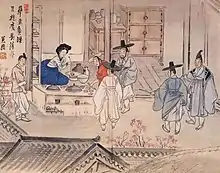 Jusageobae (holding a drinking party) by Hyewon (1758–1813) | |
| Korean name | |
|---|---|
| Hangul | 술 |
| Revised Romanization | sul |
| McCune–Reischauer | sul |
| IPA | [sul] |
| Suffix | |
| Hangul | -술 |
| Revised Romanization | -sul |
| McCune–Reischauer | -sul |
| IPA | [sul] |
| Suffix 2 | |
| Hangul | -주 |
| Hanja | 酒 |
| Revised Romanization | -ju |
| McCune–Reischauer | -chu |
| IPA | [tɕu] |
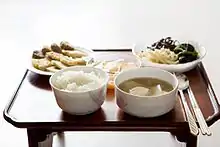 |
| This article is part of a series on |
| Korean cuisine 한국 요리 조선 료리 |
|---|
There are an estimated 1,000 or more kinds of alcoholic drinks in Korea. Most are made from rice, and are fermented with the aid of yeast and nuruk (a wheat-based source of the enzyme amylase). Fruits, flowers, herbs and other natural ingredients have also been used to craft traditional Korean alcoholic drinks. There are six distinct flavors: sweet, sour, pungent, roasted, bitter and spicy. When the flavors are balanced, the alcohol is considered good quality.
Varieties
Most traditional Korean alcoholic drinks are rice wines, fermented with the aid of yeast and nuruk (a wheat-based source of the enzyme amylase). Main varieties include clear rice wines (cheongju), milky rice wine (takju), distilled liquor (soju), fruit wine (gwasil-ju), flower wines, and medicinal wines.[1]
Milky


Makgeolli (also known as takju and nongju), is a milky, sweet alcoholic drink made from rice. It is one of Korea's most-popular alcoholic drinks. The oldest traditional Korean rice wine, its alcohol content is six to seven percent. It is fermented naturally and not filtered, which gives it its milky-white color and leaves a chalky residue at the bottom. Thick and smooth. It tastes sweet and slightly tangy, with a cool aftertaste. Makgeolli is served in a bowl, rather than a cup.
In Poetic Records of Emperors and Kings, written during the Goryeo dynasty (918-1392), the drink was first mentioned in the founding story of the Goguryeo Kingdom during the reign of King Dongmyeong (37-19 BC).[2] Makgeolli is brewed with classical methods, using nuruk (molded cereal which produces hydrolysable enzymes, decomposing macromolecules to monomers for yeast growth) cooked rice, water, barley and yeast.[3] The brewing process has two steps: seed and main mash and main fermentation. Seed mash is the process of obtaining actively-growing yeasts and enzymes in the mixture of yeast and nuruk. The main mash acquire tastes and aromas from the transformation of nutrients and amino acids derived from the rice. Main fermentation lasts for about a week.[4]
Due to the microorganisms present during fermentation, it contains 1.9 percent protein, over 10 amino acids, vitamin B, inositol and choline. Makgeolli is reported to increase metabolism, relieve fatigue and improve the complexion.[2]
A regional, slightly-creamier variant, originally from Gyeonggi-do, is called dongdongju. Another variety, called ihwaju (hangul: 이화주; hanja: 梨 花酒; "pear-blossom wine") is so named because it is brewed from rice with rice malt which ferments during the pear-blossom season.[5] Ihwaju is often so thick that it is eaten with a spoon. A similar drink is known as Gamju; this name is also used for non-alcoholic sweet drinks, including Sikhye (식혜).
Clear
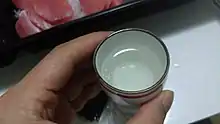
Cheongju, or yakju, is a refined rice wine made from steamed rice which has undergone several fermentation stages. Also known as myeongyakju or beopju, it is distinguished from takju by its relative clarity. Varieties include baekhaju (백하주), made from glutinous rice and nuruk,[6] and heukmeeju (hangul: 흑미주; hanja: 黑米酒; "black rice wine", made from black rice).[7]
Yakju is brewed with boiled rice, yeast and water. If chrysanthemum is included, it is called gukhwaju; if azalea is added, it is called dugyeonju; if pine sprouts are used, it is called songsunju; if lotus leaves are added, it is called ywonyeopju; if ginseng is used, it is called insamju. Takju and cheongju are sometimes distilled, with medicinal herbs added to the distilled liquor. This mixed liquor is brewed to enhance the medicinal effects of the herbs.
Cheongju is similar to Japanese sake. Chung Ha is a popular brand which is widely available in Korean restaurants. Local variations include beopju, brewed in Gyeongju.[8]
Flavoured
This yakju is brewed with flowers and leaves for a distinctive flavor. Kookhwaju (chrysanthemum wine), omijaju, songjeolju and dugyeonju are types of gahyanggokju.
A number of Korean traditional wines are produced from flowers. These include wines made from chrysanthemums (gukhwaju), acacia flowers, maesil and peach blossoms, honeysuckle, wild roses, and sweet-briar petals and berries.[9] One famous variety of flower wine, called baekhwaju, is infused with herbs as well as 100 varieties of dried flowers.[10]
Dugyeonju (두견주, 杜鵑酒) is a wine made from azalea petals which is produced in Chungcheong Province. Sweet, viscous and light-yellowish-brown in color, it contains about 21 percent alcohol. Myeoncheon Dugyeonju is the South Korean government's Important Intangible Cultural Property No. 86-2.[11]
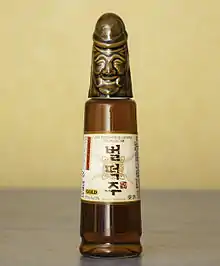
Medicinal liqueurs, known as yagyongju (약용주, 藥用酒), are produced by combining seeds, herbs and roots with alcohol.
- Baekse-ju (brand name Bek Se Ju), a commercial variant of medicinal wine, is the most popular medicinal wine among younger people (who generally do not drink it for its medicinal properties). It has become a popular alternative to soju in restaurants and bars. Baekse-ju is a rice wine infused with ginseng and eleven other herbs, including licorice, omija (Schisandra chinensis), gugija (Chinese wolfberry), astragalus, ginger and cinnamon, with 13 percent alcohol.[12][13]
- Beolddeok ju: A rice wine infused with herbal medicines and sweetened with pumpkin malt which is believed to increase male stamina. Bottles are often sold topped with a ceramic penis with a smiling face.[14][15]
- Bem ju is made by placing a snake in a jar of distilled liquor (such as soju) and aging it. It is a folk remedy which is said to be particularly good for men. Various types of snakes are used. According to local lore, the more venomous the snake, the more powerful the medicinal quality (and the higher the price).
- Chuseongju is a traditional wine made from rice and herbs, including omija (Schisandra chinensis) and Eucommia ulmoides. It is commercially available in a bamboo-shaped bottle.
- Daeipsul (대잎술) is a traditional folk wine from Damyang County in South Jeolla Province made from glutinous and brown rice, bamboo leaves and ten medicinal herbs.[16]
- Dosoju is a popular herbal wine, traditionally served on New Year's Day.[17]
- Insamju, made with ginseng, is said to be the most popular medicinal wine among older people.[18]
- Jugyeopcheongju is a traditional liquor made with bamboo leaves.[19]
- Ogalpiju is made from the bark of Eleutherococcus sessiliflorus, blended with soju and sugar.
- Sansachun is a commercial Korean wine made from the red fruit of the sansa, or Chinese hawthorn (Crataegus pinnatifida). The Bae Sang Myun Brewery Company markets this wine, claiming therapeutic effects.[20]
- Songsunju is soju made with glutinous rice and soft, immature pine cones or sprouts.[21][22]
Fortified
Honju is brewed with grain by adding soju. Gwaha-ju and songsun-ju are types of honju.
Distilled liquors
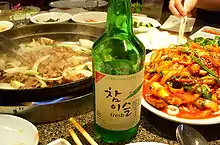
- Soju, a clear, slightly-sweet distilled spirit, is the most popular Korean liquor. It is known as "a friend of life" and "the common people's drink." Soju is made from grains (such as rice, barley and wheat) or starches, such as potatoes, sweet potatoes and tapioca. Although soju is often compared to vodka, it has a sweet taste due to added sugar. The drink is usually served in a shot glass. It has a smooth, clean taste, and pairs well with a variety of Korean dishes. Soju is generally inexpensive; a typical bottle costs about ₩1,300, less than US$1.20. It typically has an alcohol content of 40 proof (20 percent alcohol by volume).[23]
- Hongju, a red liquor made with rice, red gromwell (Lithospermum erythrorhizon), and nuruk. Made only on the Jeollanam-do island of Jindo it was originally distilled for its supposed medicinal qualities.[24] Hongju producers have committed to using only ingredients found on Jindo island.
In the 13th century, during the Goryeo dynasty, Mongol invaders brought soju (known as araki) with them.[25] Araki is derived from the Arabic araq (liquor).[26] Soju was originally developed in Arabia, and passed through Mongolia on its way to Korea. Distilled liquor was new to Koreans, who were accustomed to fermented alcoholic drinks such as makgeolli. Mongol camps such as Kaesong, Andong and Jeju Island are well-known soju-producing regions.[27] During the late 20th century, soju flavored with lemon or green tea became available. The Japanese version is known as shōchū.
Danyangbeop (single-brew) or leeyangbeop (double-brew) are traditional grain-wine brewing methods. Takju or cheongju is distilled to produce soju. Andong soju's distinctive flavor is well known in the city. Okroju from Gyeonggi Province originated in Hanyang during the late Joseon dynasty. Munbae-ju is South Korea's Important Intangible Cultural Property 86‑1. It is a traditional liquor made from malted millet, sorghum, wheat, rice and nuruk, with a strength of 40 percent alcohol by volume. Munbae-ju originated in the Pyongyang region and is known for its fragrance, which is said to resemble the flower of the munbae (pear) tree.[8][28]
Distilled liquors also include goryangju and okroju.[29]
Flavoured
Yagyong-jeungryuju (medicinal liquor) include:
- Igang-ju is a straw-colored drink which has been brewed in Jeolla and Hwanghae Provinces since the mid-Joseon dynasty. With a delicate scent, it is flavored with curcuma root, cinnamon and pears.
- Gamhongno is a traditional light-pink liquor with medicinal herbs which is popular in Pyongyang and the Kwanso region of North Korea. It is distilled three times and aged for 120 years.
Fruit wines
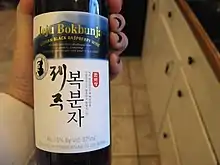
Korea has a number of traditional fruit wines, produced by combining fruits or berries with alcohol. Podoju (포도주, 葡萄酒) is made from rice wine which is mixed with grapes. The most popular fruit wines include maesil-ju (made from plums), bokbunja-ju (made from Korean black raspberries),[30] and wines made from Chinese quinces, cherries and pomegranates.

Gwasilju is usually made from fruits or grains. In the spring, people make alcoholic drinks with azaleas, forsythia, peaches and pears. In the summer, lotuses and roses are often used. In the fall, chrysanthemum, yuzu, Korean wild grapes, black raspberries and apples are often infused. In the winter, Asian apricot is sometimes used.
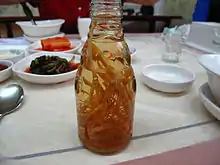
References
- "Liquor | Official Korea Tourism Organization". english.visitkorea.or.kr. Retrieved 9 November 2017.
- (KOCIS), Korean Culture and Information Service. "Say hello to the latest Korean fervor - makgeolli the rice wine :: Korea.net : The official website of the Republic of Korea". Retrieved 17 July 2016.
- Choi, Jae-Suk; Lee, Yu-Ri; Ha, Yu-Mi; Seo, Hyo Ju; Kim, Young Hun; Park, Sun-Mee; Sohn, Jae Hak (1 June 2014). "Antibacterial Effect of Grapefruit Seed Extract (GSE) on Makgeolli-Brewing Microorganisms and Its Application in the Preservation of Fresh Makgeolli". Journal of Food Science. 79 (6): M1159–M1167. doi:10.1111/1750-3841.12469. ISSN 1750-3841. PMID 24773577.
- Kang, Bo-Sik; Lee, Jang-Eun; Park, Hyun-Jin (1 June 2014). "Qualitative and Quantitative Prediction of Volatile Compounds from Initial Amino Acid Profiles in Korean Rice Wine (makgeolli) Model". Journal of Food Science. 79 (6): C1106–C1116. doi:10.1111/1750-3841.12489. ISSN 1750-3841. PMID 24888253.
- Archived 30 April 2009 at the Wayback Machine
- "Product". Archived from the original on 12 March 2007.
- "Product". Archived from the original on 15 March 2005.
- Traditional Liquor Korea Tourism Organization. Retrieved 28 August 2009
- "Flower Pancakes and Flower Liquor : Traditional Food with a Floral Fragrance". Koreana. 2003. Archived from the original on 28 September 2007.
- http://joongangdaily.joins.com/200303/27/200303270110583709900091009101.html. Missing or empty
|title=(help) - "Drinks of the Ancients". Sky News. Archived from the original on 28 September 2007. Retrieved 30 April 2013.
- "Archived copy". Archived from the original on 14 October 2008. Retrieved 21 March 2009.CS1 maint: archived copy as title (link)
- "Archived copy". Archived from the original on 14 May 2006. Retrieved 23 April 2006.CS1 maint: archived copy as title (link)
- "A Taste of the Sea and the Mountain". Koreataste. Korea Tourism Organization. 19 September 2011. Archived from the original on 11 May 2013. Retrieved 28 August 2015.
- Seo (서), Bu-won (부원) (11 March 2010). "'남근목' '벌떡주'...예스럽던 동해안은 어디로 갔나" (in Korean). OhmyNews. Retrieved 28 August 2015.
- "Afmc.co.kr".
- 도소주 (in Korean). Korean Folk Encyclopedia. Retrieved 30 April 2013.
- Pettid, Michael J. (2008). Korean cuisine: an illustrated history. China: Reaktion Books Ltd. pp. 110–123. ISBN 978-1-86189-348-2.
- "네이버 :: 마이홈/게시판 서비스 종료 안내".
- "Product". Archived from the original on 6 March 2006.
- 송순주담그기 (in Korean). Korean Folk Encyclopedia. Retrieved 30 April 2013.
- "Soju: Everything You Need to Know About Korea's National Drink | Soju Guide". VinePair. 7 March 2017. Retrieved 9 November 2017.
- Koehler, Robert (30 April 2015). Korean Wines & Spirits: Drinks That Warm the Soul (Korea Essentials No 18). Seoul Selection USA, Inc. p. 21. ISBN 978-8997639526.
- "The History of Soju and its Modernization | 10 Magazine Korea". 10 Magazine Korea. 28 July 2016. Retrieved 9 November 2017.
- Webster's New World College Dictionary (Fourth ed.). Cleveland: Wiley Publishing. 2006. p. 78. ISBN 978-0-02-863118-9.
- "Koreana : a Quarterly on Korean Art & Culture". www.koreana.or.kr. Retrieved 18 July 2016.
- "Drinks of the Ancients". SkyNews. Archived from the original on 28 September 2007. Retrieved 27 May 2016.
- "Archived copy". Archived from the original on 5 November 2006. Retrieved 23 April 2006.CS1 maint: archived copy as title (link)
- Lee, Jungmin; Dossett, Michael; Finn, Chad (2014). "Mistaken Identity: Clarification of Rubus coreanus Miquel (Bokbunja)". Molecules. 19 (7): 10524–10533. doi:10.3390/molecules190710524. PMC 6271795. PMID 25045891.
External links
| Wikimedia Commons has media related to Alcoholic beverages from Korea. |